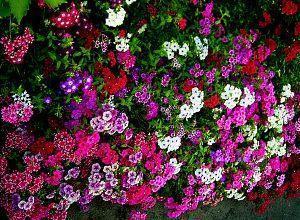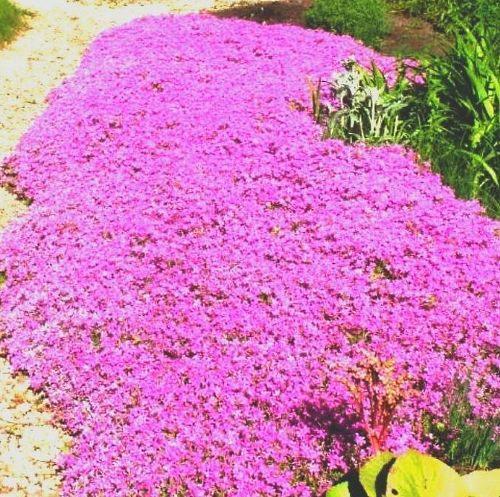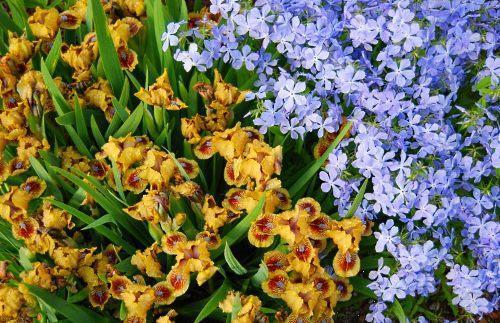A flower bed with phlox: types of flowers and their compatibility with other plants
 The strangely bright color of phlox is the best suited for the organization of flower beds. These lush blooming perennials are easy to care for. They look great and take root in the same area with other types of flowers, shrubs and herbs. This means that you can create a flower bed with phlox of any kind: mixborder, carpet, irregular or regular flower garden, group, parterre, border, array and rabatka.
The strangely bright color of phlox is the best suited for the organization of flower beds. These lush blooming perennials are easy to care for. They look great and take root in the same area with other types of flowers, shrubs and herbs. This means that you can create a flower bed with phlox of any kind: mixborder, carpet, irregular or regular flower garden, group, parterre, border, array and rabatka.
But their most important advantages are the flowering period and frost resistance.
Due to the huge number of phlox species (about 60) for a home flower garden, you can choose groups of plants that have different flowering periods. So the flowerbeds with phlox planted on the site will delight others with bright and outlandish colors (aromas) from the first truly warm spring days until autumn.
Read also about perennial delphinium!
What can be a flowerbed with phlox (photo of planting options and flowering calendar)
Among all the varieties of phlox are:
- Creeping (ground cover) plants.
This variety of flowers begins to turn green and bloom very first - somewhere in the middle - towards the end of May (depending on the weather). In most cases, designers use it to create the background of a landscape composition, in which shrubs, and other primroses, and fruit trees can participate. From creeping plant varieties, bright purple, juicy red, pink-white carpet flower beds, brook borders, massifs and ridges are obtained. Pictured unusual flower bed with phlox, the pattern of which is irregular, organized from the subulate type of flowers. It is ideal for alpine slides and single flower beds, decoration of retaining walls.

- Loose (spread out) plants.
A transitional type of phlox, which no longer spreads along the ground, since it has a small (below average) stem length. It blooms next to ground cover plant varieties and is considered the most unpretentious member of the family. And also exotic, because its inflorescences are a lush bunch of small flowers of light lilac, purple, lilac or white. Another advantage of the variety is the violet scent of flowers and the longest flowering period. It will help you evaluate how the phlox flower bed will look like, the photo below.

- Shrub undersized plants.
This phlox variety blooms for most of June and has a sweet scent. The stem of a flower does not exceed 100 cm in height, and the inflorescence consists of many small white, white-purple, deep red or dark pink flowers. These plants have one fundamental difference from their previous relatives. They love acidic soil. In it, they take root well and bloom violently. To organize a flower bed with phloxes, a diagram is not needed. This plant variety looks great in a collage flower garden.

- Shrub tall plants.
The most popular, extensive and well-known phlox variety. Some representatives of the species bloom somewhere in mid-late June, others in early July, and still others in August. Their flowering lasts about a month. Tall plants have representatives with medium-sized and large, with spotted and strange flowers in the inflorescence. And also with an unusual inflorescence.This is how phlox flower beds can be - the photo was taken in the midst of flowering.

Lush flower bed with peonies and phlox: suitable plants to combine
Before listing which of the plants phloxes make an ideal combination with, it is necessary to recall a few rules for drawing up flower beds with phloxes:
- It is better to dilute brightly flowering representatives with a dull inflorescence with non-flowering or inconspicuous flowering herbs. This combination will make it possible to present the beauty of a flower in a favorable light, and a phlox flower bed with such an organization has a more aesthetically pleasing appearance.
- Low and creeping varieties should be in the foreground when organizing a flower garden. The higher the plant, the closer to the center or edge (group, border) it should be located.
- Lush inflorescences of tall flowers are ideally combined with peonies. A photo of a flower bed with peonies and phlox will help to verify this - plants with flowers of pink-purple tones were combined.
In addition to peonies, phlox can be supplemented with: dwarf irises, hybrid primroses, muscari, dwarf coniferous shrubs, edelweiss, poppy seeds, dwarf wormwood, geraniums and many others. When choosing flowers for a flower bed with phlox, one should not forget about the flowering period of all plants. Each individual variety must be different from the others. Using this scheme of planting flowers, it will be possible to create a flower garden that will delight the eyes throughout the summer cottage period. Read:perennial Gaillardia - planting and care!